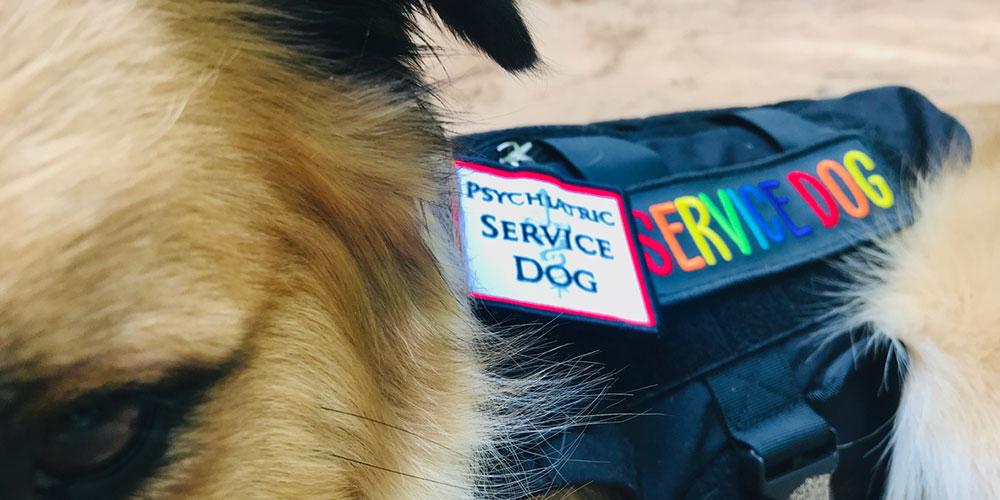Unlocking Potential: The Art of Psychiatric Service Dog Training
In a world increasingly aware of mental health’s pivotal role in overall well-being, the bond between humans and their canine companions has evolved into a life-changing partnership. Psychiatric service dogs, trained to assist individuals facing various mental health challenges, offer more than just companionship; they provide support, stability, and comfort in moments of distress. This article delves into the intricate process of psychiatric service dog training, exploring the methods, challenges, and profound impact of these four-legged therapists. Whether you’re considering the path of service dog ownership or simply curious about this transformative field, join us as we unpack the essential elements that underlie the training and work of these remarkable animals.
Table of Contents
- Understanding the Role of Psychiatric Service Dogs in Mental Health Support
- Key Training Techniques for Effective Psychiatric Assistance
- Choosing the Right Breed for Psychiatric Service Dog Training
- Navigating Legal and Accessibility Considerations for Service Dogs
- Q&A
- To Wrap It Up
Understanding the Role of Psychiatric Service Dogs in Mental Health Support
Psycho-emotional support plays a crucial role in the lives of individuals dealing with various mental health conditions. Psychiatric service dogs are trained to assist their handlers in navigating the complexities of anxiety, depression, PTSD, and other disorders. By providing companionship, they contribute to emotional stability and create a sense of safety. The training they undergo equips them to perform specific tasks that alleviate symptoms. Examples of these tasks include:
- Interrupting harmful behaviors: Dogs can gently intervene when their owner engages in self-harming actions.
- Deep pressure therapy: The weight of a dog lying on a person can reduce anxiety levels.
- Guiding during panic attacks: Dogs can lead their handlers away from triggering situations.
The unique bond between a service dog and its handler fosters a sense of belonging that is often hard to find. These animals are more than just pets; they are integral partners in managing mental health. Successful training programs focus not only on teaching specific commands but also on building a profound connection between the dog and the handler. A comparison of existing training methods can illustrate their effectiveness:
| Training Method | Focus Area | Outcome |
|---|---|---|
| Positive Reinforcement | Behavioral responses | Stronger bond and trust |
| Task-Specific Training | Defined tasks | Effective symptom management |
| Socialization | Public interaction | Increased comfort in various settings |
Key Training Techniques for Effective Psychiatric Assistance
In the realm of training psychiatric service dogs, emphasis is placed on creating a bond between the handler and the dog while ensuring that the dog can perform essential tasks. The foundation of any effective training program is consistency and positive reinforcement. Utilizing reward-based training methods, such as treats, praise, or play, helps to motivate the dog and reinforces desired behaviors. Important techniques include:
- Socialization: Exposing the dog to various environments, people, and situations to build confidence and adaptability.
- Task-specific training: Teaching the dog specific tasks that assist the handler, such as retrieving medicine, providing deep pressure therapy, or interrupting anxiety episodes.
- Set a routine: Establishing a daily training schedule to foster structure and reliability in the dog’s behavior.
In addition to these foundational methods, incorporating specialized training exercises can further enhance the dog’s skill set, enabling them to perform effectively in high-stress situations. Utilizing tools such as clicker training can improve communication between the trainer and the dog, allowing for precise feedback. Potential specialized techniques include:
| Technique | Description |
|---|---|
| Distraction Training | Teaching the dog to remain focused amidst distractions. |
| Public Access Training | Training the dog to behave appropriately in public settings. |
| Responsive Training | Encouraging the dog to respond quickly to the handler’s cues and commands. |
Choosing the Right Breed for Psychiatric Service Dog Training
When selecting a breed for psychiatric service dog training, it’s essential to consider various attributes that influence their effectiveness in this unique role. Temperament is paramount; dogs that are naturally calm, sociable, and eager to please often excel in providing the emotional support and stability needed. Popular breeds that align well with these characteristics include:
- Golden Retrievers: Known for their friendly nature and intelligence.
- Labrador Retrievers: Highly trainable, loyal, and gentle.
- Poodles: Versatile and hypoallergenic, often good with anxiety and stress.
- Border Collies: Smart and responsive, with a strong work ethic.
In addition to temperament, size and energy level should also factor into your decision. Larger dogs may provide more physical comfort and presence, while smaller breeds can be more practical for urban environments. Assessing your lifestyle can help narrow down your choices. Below is a breakdown of key breed traits that can help inform your decision:
| Breed | Size | Energy Level | Common Traits |
|---|---|---|---|
| Golden Retriever | Large | Moderate | Friendly, Intelligent |
| Labrador Retriever | Large | High | Loyal, Gentle |
| Poodle | Standard/Medium/Small | Moderate | Hypoallergenic, Versatile |
| Border Collie | Medium | High | Smart, Active |
Navigating Legal and Accessibility Considerations for Service Dogs
Understanding the legal framework surrounding service dogs is crucial for both trainers and handlers. Under the Americans with Disabilities Act (ADA), psychiatric service dogs are granted specific rights, allowing them to accompany their handlers in public spaces, including restaurants, hotels, and stores. However, it is important for individuals to be aware of the limitations of these regulations. Here are some essential aspects to consider:
- State Laws: Different states might have additional laws that define rights and responsibilities.
- Certification and Documentation: While the ADA does not require service dogs to be certified, having proper documentation can help clarify your dog’s role.
- Public Access Tests: Familiarizing service dogs with various environments, including crowded places, is fundamental to their training.
Accessibility is equally significant, as environments must be prepared to accommodate service dogs adequately. Establishing awareness among businesses and the general public fosters a more inclusive atmosphere. To promote understanding, a simple table can outline the responsibilities of service dog handlers and the rights of service dogs:
| Handler Responsibilities | Service Dog Rights |
|---|---|
| Ensure the dog is trained and well-behaved | Access to public areas without restriction |
| Maintain control over the dog at all times | Right to receive necessary accommodations |
| Provide documentation if questioned | Protection under the ADA laws |
Q&A
Q&A: Understanding Psychiatric Service Dog Training
Q1: What exactly is a psychiatric service dog (PSD)?
A: A psychiatric service dog is a specially trained canine that assists individuals with psychiatric disabilities or mental health conditions. Unlike emotional support animals, PSDs are trained to perform specific tasks that help mitigate their handler’s symptoms, such as anxiety, PTSD, or severe depression.
Q2: What skills or tasks do psychiatric service dogs typically learn?
A: Psychiatric service dogs can learn a variety of tasks tailored to their handler’s needs. These may include deep pressure therapy to calm anxiety, providing a safety boundary in public spaces, waking their handler from nightmares, reminding them to take medication, or interrupting harmful behaviors during episodes of intense distress.
Q3: How does one begin training a psychiatric service dog?
A: Training a PSD typically starts with choosing a suitable dog, often from a breed known for its temperament and trainability. The next step involves foundational obedience training, followed by task-specific training that addresses the handler’s unique requirements. Many handlers opt to work with a professional trainer who specializes in service dog training.
Q4: Can an individual train their own psychiatric service dog?
A: Yes, many individuals choose to train their own PSDs, especially if they have the knowledge and resources. It’s essential, however, to ensure that the training adheres to service dog standards, which include public access training. Handler and dog must work closely to build trust and understanding throughout the training process.
Q5: What is the difference between training methods for psychiatric service dogs and other service dogs?
A: While the core principles of obedience and task training apply to all service dogs, psychiatric service dog training often incorporates techniques that focus on emotional support and behavioral cues. Trainers may use more gradual exposure to stressors, ensuring that the dog learns to respond calmly in various situations, which can be particularly beneficial for those with anxiety or PTSD.
Q6: Are there regulations or certifications required for psychiatric service dogs?
A: Unlike therapy or emotional support animals, psychiatric service dogs have specific legal protections under the Americans with Disabilities Act (ADA). They do not require formal certification or registration, but they must have been trained to perform specific tasks related to their handler’s disability. State and local laws may have additional requirements.
Q7: How long does it usually take to train a psychiatric service dog?
A: The time it takes to train a psychiatric service dog can vary widely, depending on the task complexity and the dog’s learning pace. On average, training can take anywhere from six months to two years. Consistency and practice are key components in expediting the learning process.
Q8: What challenges might arise during the training of a psychiatric service dog?
A: Training a psychiatric service dog can present challenges, including difficulty in focusing, inconsistent responses to commands, or sensitivity to environmental stimuli. Handlers may face emotional challenges as well, particularly when navigating their mental health needs alongside their dog’s training.
Q9: Can a psychiatric service dog positively impact their handler’s mental health?
A: Absolutely! Many handlers report significant improvements in their mental health and quality of life. Psychaitric service dogs offer companionship, emotional support, and a sense of safety, which can lead to reduced anxiety levels and improved overall well-being.
Q10: What resources are available for those interested in psychiatric service dog training?
A: There are numerous resources available, including books, online courses, and local training programs specializing in service dog training. Support groups, both in-person and online, can offer valuable insights from fellow handlers and trainers to aid in the training process.
—
This Q&A offers a comprehensive look at psychiatric service dog training, addressing common inquiries while remaining neutral and informative.
To Wrap It Up
In the tapestry of mental health support, psychiatric service dogs stand out as remarkable threads woven with compassion, loyalty, and unyielding dedication. Their training, a blend of specialized techniques and a deep understanding of human emotions, ensures that these canine companions are not just pets but essential members of a support system. As we conclude our exploration of psychiatric service dog training, it’s vital to recognize the bond formed between handler and dog—a relationship rooted in trust and mutual respect.
The journey of training these remarkable animals is as much about understanding oneself as it is about teaching commands. Each session, each shared moment, enriches not only their skills but also the emotional wellbeing of those they serve. As we move forward, let us continue to champion the importance of this unique partnership, breaking down barriers and fostering understanding around mental health support. Together, we can illuminate the path for others who seek the solace and aid that only a well-trained psychiatric service dog can provide.



